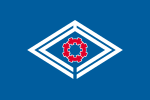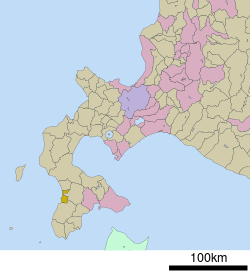Esashi, Hokkaido (Hiyama)
Esashi (江差町, Esashi-chō) is a town in Hiyama Subprefecture, Hokkaido, Japan. It is the capital of Hiyama Subprefecture.
Esashi 江差町 | |
|---|---|
Town | |
 Flag | |
 Location of Esashi in Hokkaido (Hiyama Subprefecture) | |
 Esashi Location in Japan | |
| Coordinates: 41°52′N 140°8′E | |
| Country | Japan |
| Region | Hokkaido |
| Prefecture | Hokkaido (Hiyama Subprefecture) |
| District | Hiyama |
| Government | |
| • Mayor | Yonosuke Terui |
| Area | |
| • Total | 109.57 km2 (42.31 sq mi) |
| Population (September 30, 2016) | |
| • Total | 8,117 |
| • Density | 74/km2 (190/sq mi) |
| Symbols | |
| • Tree | Thujopsis |
| • Flower | Japanese Rose |
| Time zone | UTC+9 (JST) |
| City hall address | 193-1 Aza-Nakauta-chō, Esashi-chō, Hiyama-gun, Hokkaidō 043-8560 |
| Website | www |
One of the oldest towns in Hokkaido, the name Esashi comes from the Ainu word for kombu, a type of edible kelp well known in Japan. It is the birthplace of a folk music tradition called Esashi oiwake.
Geography
Esashi is a district and port town located on the western seaboard of Hokkaido on the Assabugawa river, facing the Sea of Japan. Its eastern part is mountainous. The town is bordered by the municipalities of Kaminokuni, Assabu and Otobe. It has a ferry connection to Okushiri island. The rail link was discontinued in 2014; Esashi Station was the terminus of the Esashi Line.[1]
Kamome Island in the town is part of Hiyama Prefectural Natural Park.
Climate
Esashi has a humid subtropical climate (Köppen climate classification Cfa) with far less snow in winter than elsewhere in Hokkaido due to the influence of the warming tsushima-kairyu ocean current.
| Climate data for Esashi | |||||||||||||
|---|---|---|---|---|---|---|---|---|---|---|---|---|---|
| Month | Jan | Feb | Mar | Apr | May | Jun | Jul | Aug | Sep | Oct | Nov | Dec | Year |
| Average high °C (°F) | 1.0 (33.8) |
1.2 (34.2) |
4.7 (40.5) |
10.5 (50.9) |
14.9 (58.8) |
18.9 (66.0) |
22.9 (73.2) |
25.9 (78.6) |
22.1 (71.8) |
16.2 (61.2) |
9.7 (49.5) |
4.0 (39.2) |
12.7 (54.8) |
| Daily mean °C (°F) | −1.4 (29.5) |
−1.3 (29.7) |
1.9 (35.4) |
7.1 (44.8) |
11.4 (52.5) |
15.5 (59.9) |
19.8 (67.6) |
22.3 (72.1) |
18.6 (65.5) |
12.8 (55.0) |
6.7 (44.1) |
1.4 (34.5) |
9.6 (49.2) |
| Average low °C (°F) | −3.9 (25.0) |
−3.9 (25.0) |
−0.9 (30.4) |
3.7 (38.7) |
8.2 (46.8) |
12.5 (54.5) |
17.1 (62.8) |
19.5 (67.1) |
15.2 (59.4) |
9.2 (48.6) |
3.6 (38.5) |
−1.2 (29.8) |
6.6 (43.9) |
| Average precipitation mm (inches) | 98.4 (3.87) |
68.7 (2.70) |
65.3 (2.57) |
83.3 (3.28) |
81.2 (3.20) |
79.5 (3.13) |
130.9 (5.15) |
141.7 (5.58) |
149.4 (5.88) |
103.5 (4.07) |
107.8 (4.24) |
99.2 (3.91) |
1,208.9 (47.58) |
| Average snowfall cm (inches) | 57 (22) |
40 (16) |
19 (7.5) |
1 (0.4) |
0 (0) |
0 (0) |
0 (0) |
0 (0) |
0 (0) |
0 (0) |
6 (2.4) |
30 (12) |
153 (60.3) |
| Average relative humidity (%) | 71 | 69 | 68 | 72 | 78 | 82 | 84 | 81 | 74 | 69 | 68 | 70 | 74 |
| Mean monthly sunshine hours | 37.2 | 60.2 | 130.9 | 173.0 | 181.1 | 163.1 | 149.3 | 165.4 | 166.8 | 147.8 | 69.1 | 34.4 | 1,478.3 |
| Source: NOAA (1961-1990) [2] | |||||||||||||
Culture
The area is home to Esashi Oiwake, a traditional Japanese folk music derived from mago-uta verses from Shinshu which spread throughout Japan during the Edo era and have become an Esashi art form.[3] The district holds a national oiwake convention each September. The oiwake musician 青坂満 comes from Esashi.
The ubagami-daijingu dogyo festival, based around the ubagami-daijingu shrine, is celebrated in August.
Esashi was the subject of the 1992 single Esashi love-song by Yuka Õne.
The town also has a celebrated historical dance: Doba Shishimai. The dance's three acts include a Shinto ritual dance of three fawns, a pestle-swinging dance and a dance of hinds quarreling over a fawn.[4]
Esashi has an official sister town, Notogawa (now part of Higashiõmi city) in Shiga prefecture. It also has official friendship status with Suzu city in Ishikawa prefecture.
History
In the Edo period, Esashi grew wealthy as a herring fishing town. The town's prosperity coined a saying, "Even Edo is not as busy as Esashi in May" and visitors to the town described the quantity of herring being so great that it turned the color of the sea white.
Several Meiji-era residences of those who grew wealthy on the trade are preserved in the town today, including the Sekikawa family country house and the Nakamura family house. The majority of Esashi's historic buildings are located on Esashi Inishie Road.
The fisheries failed around the turn of end of the 19th century and the town tried to replace its major industry with tourism. The town advertised itself using the Min'yo classical Japanese folk song, the main part of which was originally from the village of Oiwake in central Japan, but became known as Esashi Oiwake as the town's version gained renown.[5]
- 1900: Esashi Town became a First Class Village.
- 1955: Esashi Town and Tomari Village were merged to form the new town of Esashi.
Education
- High school
- Junior high schools
- Esashi Junior High School (江差町立江差中学校)
- Esashi Kita (North) Junior High School (江差町立江差北中学校)
- Elementary schools
- Esashi Elementary School (江差町立江差小学校)
- Esashi Kita Elementary School (江差町立江差北小学校)
- Minamigaoka Elementary School (江差町立南が丘小学校)
Sister cities


References
- 江差線木古内—江差間が廃止される [Esashi Line section between Kikonai and Esashi closes]. Japan Railfan Magazine Online (in Japanese). Japan: Koyusha Co., Ltd. May 12, 2014. Retrieved May 13, 2014.
- "Esashu Climate Normals 1961-1990". National Oceanic and Atmospheric Administration. Retrieved December 29, 2012.
- Japan Foundation Information Centre Archived 2007-06-23 at Archive.today, loaded 15 May 2007
- Esashi Official Website Archived 2007-11-10 at the Wayback Machine, loaded 15 March 2007
- The International Shakuhachi Society Archived 2007-04-17 at the Wayback Machine, loaded 15 March 2007
- Hokkaido Esashi High School
- Sister cities of Suzu
- "Higashiomi:Links". Archived from the original on 2015-05-10. Retrieved 2015-05-23.
External links
![]()
- Official Website (in Japanese)